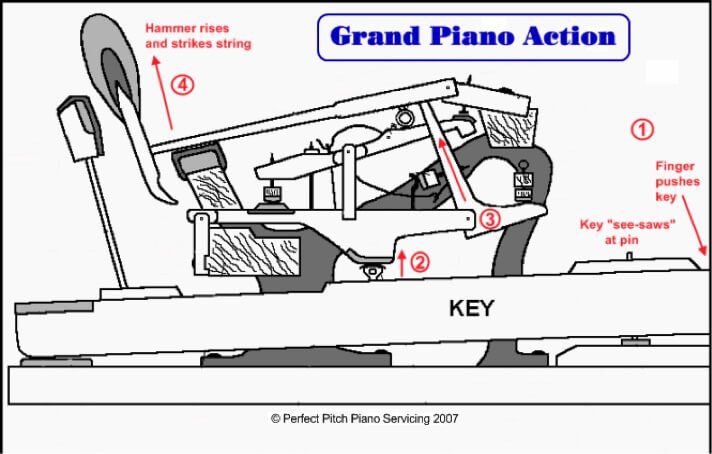How a Grand Piano Works
The dictionary definition of a grand piano is that it is “a large, full-toned piano that has the body, strings, and soundboard arranged horizontally and in line with the keys and is supported by three legs.” That is true, but it hardly touches on the complexity and magic of grand pianos and their parts. In spite of the magnificent assortment of exterior piano cases, the interior is the heart of the grand piano and its performance values. There are thousands of parts, and it is the quality of the manufacturing and materials of these parts and the expertise of the assemblage of them that makes one grand outdistance another. For this reason alone, it behooves people to know something about the instruments they play and purchase.
Whether it’s a baby grand under five feet long or concert grand over nine feet long, the grand piano with a faster touch and a larger sound, is considered more powerful and responsive than upright pianos in general.
So, let’s open the lid and examine what’s inside these really grand pianos.
The Plate
The large cast iron metal plate (often called “the harp”) could be thought of as the spine of the grand piano because it is used to hold over 20 tons of string tension in place. There are two types of plates on the market today: a sandcast and a v-pro plate. Most high-end grand pianos for sale include the sandcast because when it is manufactured, all the air bubbles are eliminated from the metal, thus producing a piano with a pure tone that gets no ringing from the plate. The quick v-pro plate production allows bubbles to get trapped in its metal, and while the plate is thinner, these plates will ring and typically interfere with the pure tone of the piano.

The holes in the plates allow the metal to cool evenly, and plates are designed by each manufacturer with logos and patent information.
The Pinblock
The ability of a piano to stay in tune depends on the quality of the pinblock which holds the tuning pins in place. Should one of the pins yield to the tremendous string tension, the piano goes out of tune. A special glue is used to laminate layers of the hardest wood to fashion a secure grip on the steel tuning pins. Old pianos frequently are heavily worn, and the holes may not hold the pins tightly, thus requiring installation of oversized pins or installing a new pinblock entirely. Cheap pianos made with inferior woods and workmanship will also need more frequent tuning.

The Soundboard
Beneath the plate and the strings is the amplifier, a large thin wooden board that radiates a large volume of sound over a wide frequency range. (All stringed instruments have some kind of soundboard). This thin wooden amplifier is not one solid piece of wood but made of many smaller planks glued together in strong, but lightweight and flexible woods. Bridges are affixed to the soundboard to hold the strings in place at an extremely high tension. The bridges must be a very hard wood to keep the strings from cutting in. The bottom of the soundboard has softer wooden ribs or braces perpendicular to the grain of the wood, to strengthen it and distribute vibrations across the soundboard better.

The Strings
Grand piano strings attach to hitch pins near the tail of the piano and to tuning pins on the pinblock. More than 200 strings made out of tempered high carbon steel (also known as spring steel) are properly fit, installed and tuned. A lot of smaller parts like felts, hammers, hitch pin and bridge pins are used to guide, customize and affix the mighty strings.

From manufacturer to manufacturer, indeed from model to model, the string configurations can and will differ. Each note is created by single, double and even triple strings of varying lengths and girths. Some strings are copper wound to affect sound and tone. They can be cushioned and tautened, loosed and crossed. It is a brain teaser to comprehend the scope of piano stringing, the nuance and subtleties of how each note is wrought from design and engineering skills. Pianos are truly marvels of mechanical genius and keep evolving with the times.
Action
The action of a piano is the mechanical assembly which translates the depression of the keys into rapid motion of a hammer, which creates sound by striking the strings. Of course, based on all the information learned about the parts above, we know it isn’t quite that simple. More aptly, we could call action the physics of the piano. It converts the touch of the pianist’s fingers on the piano keys into a mechanical flow of energy toward the string, achieved in interaction with the force of gravity.

Action is also defined in different types. The direct action of an upright is the best vertical action. It is quicker with fewer moving parts and allows faster repetition.
The grand piano action is the most responsive action using gravity more and relying less on springs than direct action.
The action is one of the most subjective areas when choosing a piano. Pianists who buy a piano with little resistance will have difficulty playing softly. Too much resistance and it will be difficult to play loudly. Beginners should probably ask for a medium action. The regulation of the action by a highly-skilled technician is a vital component of proper ongoing piano service.

Tips on Choosing A Piano
See our complete blog post on “Choosing a Piano.” Here is a small summary:
1. Buyer beware! There are many old “cheap” pianos being hawked on ebay, craig’s list, and at bargain piano stores. If the price of a piano seems too good to be true, it probably is. A piano that has suffered damages may appear to be okay, but unless an expert examines it first, do not be fooled.
2. Get an education. With the advantages that the Internet provides, everyone today can begin to educate themselves without leaving their chair. Start by investigating Brand Names and Manufacturers. No longer is the cookie-cutter brown baby grand in demand, but a whole new smorgasbord of colors, designs, woods, sizes and décor is available.
3. Get out and about. A truly good piano store will not try to sell you on the available floor inventory, but will listen to your needs, and attempt to help you find the instrument that is the best grand piano. Don’t settle on a piano until you have found the experts that can help you. Piano sellers should be able to give you direction and objective information in your quest. Due to the nature of this product, the hard sell has no place in this industry.

